El Cadejo: Guardian of the Night and Dawn
Reading Time: 14 min
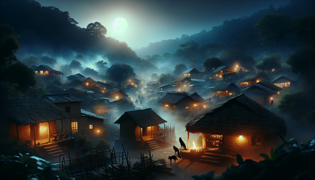
About Story: El Cadejo: Guardian of the Night and Dawn is a Folktale from guatemala set in the Contemporary. This Descriptive tale explores themes of Good vs. Evil and is suitable for All Ages. It offers Cultural insights. A mystical journey through Guatemalan legends where darkness and light share one soul.
Introduction
In the humid embrace of a Guatemalan night, where cicadas serenade and the dense foliage of the highland jungles whispers secrets of antiquity, a subtle tension held the air. The village of San Miguel de las Lomas, with its weathered adobe walls and quiet brick-paved courtyards, lay cradled by mist and memories. Elders spoke in low voices of legends both feared and revered, and among these whispered tales the name El Cadejo resonated like the distant echo of an unresolved hymn. It was said that this creature, half myth and half spirit, walked on four silent feet under the moon's pale gaze. One form, cloaked in shadows and menace, roamed the nighttime paths bringing dread to those who wandered too far from safety; the other, a luminous white figure, appeared at times of dire need to shelter the innocent from harm.
Nightfall in San Miguel was more than the closing of day – it was the opening of a portal to realms where nature and myth overlapped. The flickering flame of torches danced on mud walls, and hushed prayers rose from humble doorsteps as families huddled together. The smell of roasted corn mingled with the damp earth and the sweet decay of tropical blooms. In these early hours, every gaze was drawn to the darkened outskirts, where the latent energy of old magic stirred among twisting vines and ancient trees.
Within this stirring darkness lived Carlos, a young man whose curiosity was matched only by his reverence for his forebears. Since childhood he had been ensnared by the dual nature of El Cadejo—a protector and a predator, forever entwined in a fate that mirrored the eternal battle between light and shadow. With each whispered legend and every lurid warning, Carlos’s inner world teetered between fear and fascination. Even as the stagnant heat of a humid night pressed in around him, his eyes burned with an inner search for truth: a desire to see not just a creature of myth but a living symbol of the unknown depths of the human spirit.
Whispers in the Twilight
As dusk deepened into night, San Miguel de las Lomas transformed into a realm where every sound carried a hidden meaning. In the central square, beneath an old colonial clock tower, villagers gathered in small clusters. They spoke in hushed tones about omens and secretive appearances, their voices mingling with the rustle of palm fronds and the rhythmic cadence of distant marimbas. Carlos found himself in the midst of these murmurs, his heart pounding with both trepidation and the thrill of forbidden inquiry. The legend of El Cadejo had long been woven into the tapestry of his childhood. His abuela, with hands scarred by time and eyes steeped in sorrow, had once recounted a tale of a dog-like spirit with eyes like burning coals; one shadowy and malevolent, the other brilliantly white and strange in its kindness.
At the village’s modest community center—a weather-beaten hall lined with sepia photographs of ancestors—an elderly priest recounted stories of old. "El Cadejo drifts between realms," he intoned, voice echoing off stone walls. "He is a judge of souls and a messenger of fate, a reflection of our inner duality. When you see his dark form, beware the sins of unchecked desire; when you see him in white, know that hope has found you." Carlos listened intently, his imagination alight with images of a spectral dog, shifting seamlessly from a menacing shadow to a guardian angel. The narrative wove a spell: every creaking branch and every shifting shadow on the wall took on a symbolic gravity.
Determined to witness the paradox for himself, Carlos began a quiet exploration through the labyrinthine alleys and rural paths beyond the village. His footsteps echoed against ancient cobblestones as he retraced routes spoken of in whispered lore, led only by the half-light of flickering streetlamps and the memory of his grandmother’s elegant, trembling voice. In his heart, he knew that the truth of El Cadejo was not merely a tale of terror; it was a mirror capturing the duality inherent in every soul—an eternal struggle between cruelty and compassion. As the wind stirred the scent of rain on the parched earth, Carlos prepared himself for an encounter that, he feared, might alter the very fabric of his existence. The night seemed to lean in closer around him, every shadow a potential harbinger of something beyond mortal understanding.
In a narrow alley marked by crumbling stone and vibrant murals of saints and folkloric creatures, Carlos paused, his senses straining for the slightest hint of supernatural presence. The air felt charged, as if echoing a silent heartbeat of the universe. In that charged moment, the village and its age-old legends seemed to merge with the present, leaving Carlos suspended between fear and an unyielding desire to uncover the essence of the mythical creature that haunted their collective dreams.
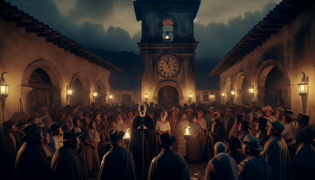
Encounter on the Moonlit Path
A week after the fervent discussions in the central square, Carlos found himself compelled to venture further into the night's embrace. It was an unusually cool evening, and the moon hung like a silver guardian over the dense forest that bordered the village. The path he followed, a narrow trail marked by wild orchids and thorny undergrowth, seemed to breathe with an otherworldly life. Shadows danced erratically beneath towering ceiba trees, and the soft murmur of a distant stream added a rhythmic quality to the nocturnal symphony.
While walking this solitary road, Carlos suddenly halted. A low, mournful howl, not quite animal and not quite human, rippled through the still air. The sound sent shivers down his spine and his breath became shallow. He recalled the old warnings: that the dark form of El Cadejo manifested when malice or despair took hold of one’s spirit. The night around him grew palpably heavier, each sound resonating with portent. In the distance, a pair of eyes glimmered with an unnatural sheen—a hint of ruby red beneath the canopy of stars.
Hesitant yet driven by both fear and curiosity, Carlos edged closer to the source of the eerie light. His heart pounded in his ears as he murmured, "Who’s there?" but the silence that followed was as thick as the humid jungle air. Suddenly, emerging from behind a cluster of tangled vines, the creature materialized. It was the dark guise of El Cadejo—a massive, sinuous form cloaked in midnight fur. Its eyes glowed with an ominous light, and each measured step exuded both grace and a preternatural threat. Carlos’s instincts screamed to flee, yet a deeper force kept him rooted to the spot.
The creature’s presence was overwhelming, its dark aura nearly palpable. For a few long, breathless moments, there was a mutual, unspoken recognition between man and spirit—a collision of innocence and ancient power. The dark Cadejo’s lips moved in a silent snarl, as if reciting a lament of ages past. Unable to move, Carlos could only watch as those terrifying eyes seemed to stare directly into the labyrinth of his soul, dredging up secret regrets and unspoken sins. But as quickly as the encounter seemed to threaten his very existence, the creature paused, tilting its head as though considering something.
In that moment, an unlikely dialogue took shape. The silence was broken by the soft rustle of leaves and the distant call of an owl. Carlos’s whispered tone, fragile and trembling, filled the void: "I mean no harm. I only seek to understand." The dark form, rather than attacking, slowly retreated into the shadows, its eyes lingering with an enigmatic intent. The thrill of terror mingled with an unexpected pang of compassion as Carlos realized that what he had witnessed was not a mindless beast but a living embodiment of life's darker truths—the fear of our own hidden selves.
As the night reclaimed its rhythm, Carlos stood alone on the moonlit path. His encounter with the dark El Cadejo left him with more questions than answers. Was the creature merely a herald of doom or a guardian ensuring that those who stray too far confronted the consequences of their inner demons? The forest seemed to whisper that both could be true, beckoning him deeper into a mystery that straddled the realms of the supernatural and the very human.
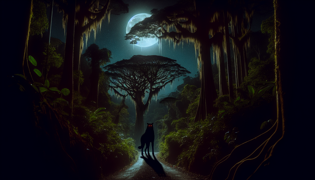
Beneath the Veil of Shadows
In the days that followed his unnerving encounter, Carlos sought the wisdom of those who had lived long enough to see the ebb and flow of legends. His search led him to Don Ernesto, an elderly folklorist whose mind was as vast as the ancient highland skies and whose voice possessed the cadence of forgotten rituals. Don Ernesto resided on the outskirts of the village in a modest adobe cottage adorned with relics and photographs, each a token of a past steeped in mystery.
Over a steaming cup of herbal tea infused with the aroma of local spices, Don Ernesto recounted the saga of El Cadejo with a measured, almost sacred tone. "The spirit is not one, but two; it embodies the duality of all existence," he explained. "In moments when hearts are hardened by bitterness, the dark Cadejo emerges to remind us of the consequences of unchecked anger and despair. Yet, when benevolence and selflessness bloom, the white Cadejo appears as a shield, a luminous guardian for those who find themselves vulnerable in the life’s storm." His eyes, twinkling with a blend of sorrow and hope, met Carlos’s inquisitive gaze.
As the old man spoke, memories of his own youth spilled forth—a time when he, too, had once encountered the enigmatic spirit. In vivid recollections, he described how a white, radiant canine had appeared on a rainy night to guide him out of a treacherous ravine, its presence soft as moonlight and warm as a cherished embrace. "In that moment," he murmured, "I understood that even the most feared legends contain within them the seeds of mercy and redemption." Carlos listened, absorbing every word as if it were a sacred incantation. The narrative painted a portrait of El Cadejo that was as layered as life itself—a being capable of both lament and solace, condemning and forgiving.
These stories resonated deeply with Carlos, stirring conflicts within him. The memories of his own past missteps—the petty transgressions, the moments of selfish indifference—cast shadows on his soul. He began to see parallels between his internal battles and the external manifestations of the canine spirit. In the darkness, the curse of guilt and regret took tangible form, while in the bright, unexpected glimmers of kindness, hope reemerged. The duality was a mirror reflecting his fears and his aspirations simultaneously.
Late one evening, as rain pattered softly on tin roofs and the scent of wet earth filled the air, Carlos ventured out with Don Ernesto’s words echoing in his mind. Wandering near an ancient ruin—a forgotten temple overtaken by creeping vines and time—he felt the presence of something beyond the ordinary. In the stagnant silence, he perceived fleeting silhouettes darting behind crumbling stone arches. It was as if the ruins themselves were sentient keepers of memories, silently guarding the interplay of light and shadow. The ghostly presence of the dark Cadejo felt ever nearer, a symbiotic echo of the turmoil within Carlos’s own heart.
In that haunted interlude, every rustle of leaves and every drip of rain from the broken canopy became laden with meaning. The ruins, bathed in intermittent flashes of lightning, seemed to whisper secrets of redemption that only the courageous—those willing to confront the darker recesses of their souls—could truly comprehend.
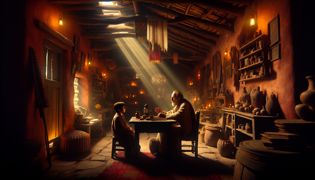
The Embrace of Dawn
The cycle of night is invariably followed by the promise of dawn, and for Carlos, this turning point came on a morning of extraordinary clarity. The oppressive tension of the nights that had haunted him began to lift as the first gentle beams of sunlight pierced the lingering mist over the highland plains. With renewed resolve, Carlos embarked on one final journey to the ancient temple nestled at the fringe of the jungle—a place whispered about in legends as the threshold between mortal grace and the supernatural.
In the soft, early light, the temple revealed its true nature. Stone pillars encrusted with moss and delicate carvings hinted at a history of devotional rites and secret ceremonies. The air was cool, carrying the faint echo of past chants and the scent of wild jasmine, as if nature herself offered benediction. It was here, amid this sanctified ruin, that Carlos longed for absolution, a deeper understanding of the dual spirit that had so haunted his nights. The temple, both a relic and a beacon, seemed to pulsate with ancient energies that bridged the visible and the unseen.
As he wandered the crumbling corridors, a subtle warmth began to infuse the cold stone—a warmth that signaled the arrival of the white form of El Cadejo. Out of a patch of sunlight streaming through a shattered roof, there emerged a majestic canine cloaked in shimmering white fur. Its eyes, soft and luminous, radiated compassion rather than menace. In that moment, time appeared to suspend. Carlos’s heart, still heavy with the regrets of past transgressions, fluttered with a cautious hope. Slowly, the white figure approached, its gait measured and humane, as if it recognized the potential for redemption in the young seeker.
Gathering his wavering courage, Carlos extended a trembling hand toward the spectral guardian. The creature responded by gently nuzzling his palm, a silent vow of protection and acceptance. In an almost wordless communion, a transformation took hold. The protective presence seemed to smooth away the jagged remnants of fear and guilt, replacing them with a profound serenity borne of forgiveness and the promise of new beginnings.
Amid the interplay of soft dawn light and emerging shadows, a dialogue of souls unfolded. The white Cura de la Luz, as some began to call the guarding aspect of El Cadejo, seemed to impart a lesson far greater than any whispered in fearful tones during the night. Here, in the hallowed remains of an ancient sanctuary, Carlos realized that the battle between darkness and light was not external but resided within each heart. The spirit’s dual nature was a mirror reflecting our inner conflicts: procrastinated hate on one side and the potential for heartfelt redemption on the other.
Stepping out from the temple into the tender embrace of a new day, Carlos felt reborn. The lush Guatemalan landscape, now bathed in the soft radiance of sunrise, no longer appeared as a realm of lurking nightmares but as a canvas filled with hope. The white and dark facets of El Cadejo had converged within him—a realization that even within the shadows of our souls, light can always find a way to break through.
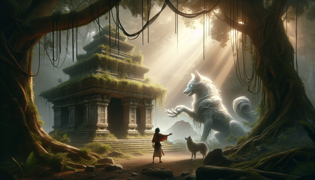
Conclusion
In the days that followed, the mystery of El Cadejo continued to echo in the hearts and memories of those touched by his presence. For Carlos, the journey had transformed him from a curious youth haunted by shadows into a man who came to embrace the inherent duality of life. He learned that every force, however ominous it might appear, carries within it both the potential for destruction and the promise of protection. The dark nights were no longer merely a time for terror but an opportunity to confront the demons within, while the gentle glow of dawn offered a chance to heal and begin anew.
With a new sense of purpose, Carlos dedicated himself to preserving the ancient wisdom of his people—ensuring that the stories of yore, with all their enigmas and lessons, would be passed down to those who came after. In the quiet hours of the morning, he would often wander the village, his eyes alert and his heart open, ready to guide a lost soul or to share a word of solace. The legend of El Cadejo had taught him that fear and compassion are intertwined; that to truly understand the world we must acknowledge its darkness even as we seek the light.
The village of San Miguel de las Lomas, too, began to shift in its perception. The once dreaded myth now served as a reminder that every shadow has its counterpoint—a luminous energy that stands to protect and to restore. As villagers spoke of the dual spirit in tones of reverence rather than fear, they embraced a philosophy where each hardship was met with the possibility of redemption. And so, the eternal dance of darkness and light continued, echoing the timeless story of humanity itself—a story of struggle, resilience, and the ever-present hope that even among the deepest shadows, the dawn will always come.
















